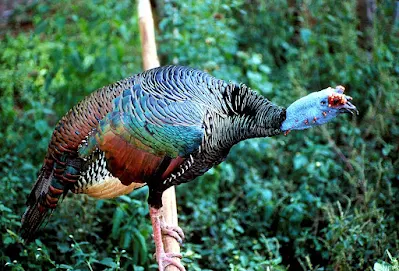25+ Interesting Facts About Turkeys
- The turkey is a large bird native to North America. It has two extant species: wild turkeys (eastern and central North America, particularly in the USA) and ocellated turkeys (Yucatan Peninsula in Mexico).
- Indigenous people of North America domesticated wild turkeys around 2,000 years ago. However, this process never happened for ocellated turkeys.
- Europeans initially transferred Turkey from its native land to Europe during the 16th Century. It arrived in Spain in 1519 and in England in 1541.
- The name of this bird is after the Eurasian country of a similar name, Turkey. It is either due to its transportation from Turkey to Britain or due to its resemblance to another bird named “Turkey coq.” (Source)
- Turkeys belong to the turkey-pheasant branch of the pheasant family. Its closest relatives are prairie chickens, ptarmigans, and grouse.
- Wild turkeys appeared on Earth around 5 million years ago. There were 10 million turkeys before the arrival of Europeans in the Americas. However, their numbers were reduced to 200,000 by the 1930s due to unrestricted hunting and habitat destruction. Later, releasing wild birds in extinction sites and better hunting management increased their population to 6.5 million. (Source)
- In 2017, paleontologists discovered fossils of giant flying turkeys in Australia. These ancient birds, present between 1.6 million and 10,000 years ago, were four times the size of modern turkeys. Despite their large size, they used to fly due to their long and powerful wing bones. (Source)
- There are several prominent differences between male and female turkeys. Males are significantly larger and more colorful than females. Snoods and fanning tails are also limited to male turkeys. All males possess longer chest hairs, known as beards, while this feature is present in only 10% of female turkeys.

Male turkeys are more colorful than females - Turkeys can change the color of their head from red to white and blue when they are excited. This procedure has assisted scientists in developing a synthetic toxin sensor. (Source)
- Domesticated turkeys cannot fly due to their strong breast muscles. However, wild turkeys can fly for short distances. It is among the five largest flying birds in the world. (Source)
- Snood is a long red fleshy part of male turkeys that usually hangs from their forehead to bill. Female turkeys usually choose males with longer snoods for mating. Farmers usually de-snood chickens of domestic turkeys to protect them from injury or infection.
- According to research, turkeys with long snoods can get better protection against diseases without wasting energy on hyperimmunity. (Source)
- Cannibalism has been observed among turkeys in large crowded farms. This behavior can happen when they suffer from boredom. (Source)
- According to research, chickens and turkeys are closer to dinosaurs than other birds. It is due to fewer changes in their chromosomes than other fowls. (Source)
- Turkeys, particularly males, sometimes behave aggressively towards humans during breeding seasons. They may also peck windows and other shiny objects by considering their reflection as another turkey.
- Turkeys are omnivorous that eat plant food (nuts, berries, tubers, flowers, etc.), insects, amphibians, and some reptiles.
- It is possible to know about the gender and age of turkeys by viewing their droppings. Males have j-shaped poop compared to spiral-shaped feces in females. The diameter of the bird’s dropping increases as it ages.
- Turkeys have two stomachs for digestion in the absence of teeth. The gizzard grinds the food while the glandular stomach softens it through gastric juices. They fill the gizzard with stones and dirt that assist in the grinding process.
- Benjamin Franklyn was one of the members designing the seal of the USA after independence. There is a misconception that he preferred turkey to bald eagle based on a private letter. However, he publically proposed a biblical event for the Great Seal. (Source)
- Turkeys have nearly three times better vision than humans, while their visual field is 270 degrees around them. These birds have color vision and can additionally see UVA light. (Source)
- According to a study, breeds of domestic turkeys from Mexico and Spain have the highest genetic diversity than their population from other areas. (Source)
- There is a common misconception that turkeys are the dumbest domesticated animals. However, they demonstrate their intelligence through complex social structures, curiosity, and individual personalities. (Source)
- People in the USA eat a large quantity of turkey meat on Thanksgiving Day. However, their highest per capita consumption is in Israel, nearly double the amount in America. Israel established several turkey farms after its formation in 1948 due to this bird’s inexpensive and tougher meat. Israelis later continued to use this meat despite their affordability for beef and chicken. (Source)
- According to estimates, more than 45 million turkeys are slaughtered annually for Thanksgiving Day. Almost all of them are from factory farms. (Source)
- Turkeys have several natural predators. These include mammals (raccoons, coyotes, bobcats, etc.), birds (great horned owls and golden eagles), and snakes.
- Wild turkeys usually live for three to five years. The lifespan for domestic turkeys is up to 10 years.



Comments
Post a Comment